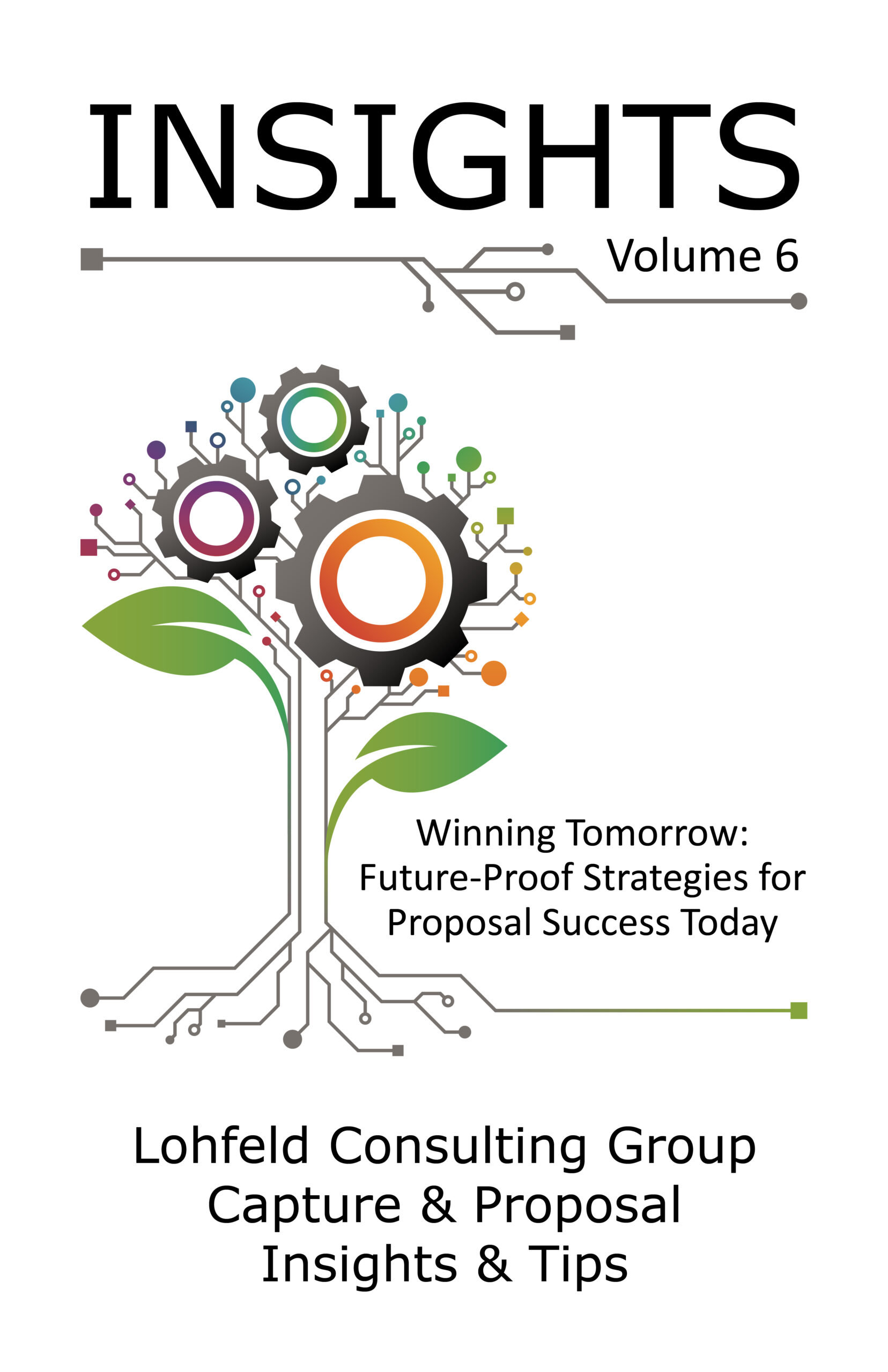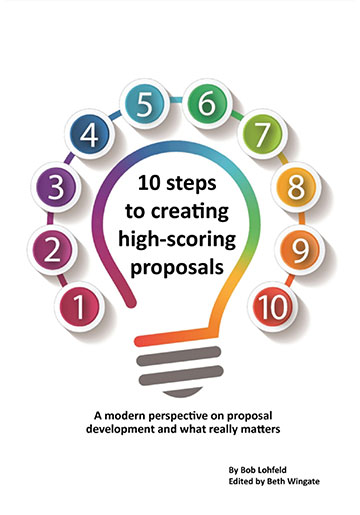How to Build Proposals that Win and Wow

Every proposal tells a story, but only the best ones win and wow the customer. Winning proposals don’t happen by accident; they are built through structure, strategy, and precision. They must demonstrate mastery of the customer’s mission, articulate measurable strengths, and be developed efficiently. At Lohfeld Consulting, we identified 22 dimensions of proposal excellence, organized into six essential groups from building a strong foundation of compliance to achieving efficiency and cost-effectiveness.
These six groups form a practical blueprint for turning proposal development into a disciplined, repeatable process that consistently produces high-scoring, compelling submissions.
1. Foundation: Compliance and Responsiveness
Winning proposals begin with a rock-solid foundation. Compliance proves you can follow instructions, responsiveness shows you understand the mission, and customer insight demonstrates that you know the “why” behind the requirement.
- Compliance: Every “shall” and “must” in the RFP is mapped and answered.
- Responsiveness: The proposal describes how the offeror will perform the work in as much detail as the proposal real estate provides.
- Customer Insight and Focus: The proposal demonstrates a detailed understanding of the customer objectives, requirements, risks, and dependencies, and clearly explains how the solution addresses them.
Example: The understanding section is often an evaluated criterion; suppose the offeror provides a detailed description of the customer’s objectives, requirements, and schedule, as well as potential risks, dependencies, and stakeholder issues that might affect them. In that case, the customer will likely score the proposal section as a strength.
2. Strength-Based Strategy
The government awards strengths when features deliver proven, measurable benefits that exceed requirements while reducing risk and offering exceptional value. For this discussion, strengths don’t always incur additional costs, as is the case with the expertise and capabilities of your staff or physical location.
- Strengths: Highlight how your solution offers a benefit the customer wants and exceeds their requirement.
- Differentiation: Describe how your solution offers a unique capability that competitors can’t match.
- Risk Mitigation: Describe how your solution identifies and mitigates risk proactively before it impacts operations.
- Innovation and Value: Describe how your solution offers a new approach that provides the best value to the customer.
Example: A contractor quantified how an innovative predictive maintenance algorithm identified and reduced downtime by 20%. The proposal explained why it mattered to the customer’s mission reliability and turned a technical detail into an evaluated strength.
3. Persuasion and Credibility
Evaluators don’t just score facts; they evaluate trust, reliability, and confidence. The following proposal attributes build credibility and persuade evaluators that your company offers the lowest risk and highest value.
- Clarity: Eliminate jargon and make every sentence easy to read.
- Credibility: Back up every claim with past performance and metrics.
- Brevity: Clearly and succinctly document your description and substantiation.
- Persuasiveness: Align benefits with the evaluator’s scoring criteria.
Example: An offeror opened each section with a one-sentence claim: “We reduce claim processing time by 30% using proven automation tools.” The offeror followed the claim with data from similar programs, customer quotes, exceptional CPAR scores, and the results of third-party studies.
4. Presentation and Design
Design influences evaluators’ comprehension and scoring, and strong visuals can significantly impact how they perceive your proposal.
- Visual Design: Use clear graphics, color, and white space to guide the eye.
- Evaluator Experience: Organize proposal content so that strengths and compliance are easy to find.
- Integration: Ensure strengths are easily identified across all evaluated criteria.
Example: High-scoring proposals include a compliance matrix and references to the RFP section in their headings. The proposal manager designs the proposal layout before writing begins to facilitate easy identification of the proposal’s strengths. This is achieved by using graphics, tables, and bold fonts to highlight strengths, and optimizing proposal white space to facilitate the easy identification of these strengths.
5. Execution and Team Performance
Behind every successful proposal is a disciplined, collaborative team. Execution quality reflects your organization’s maturity and reliability.
- Teaming and Collaboration: Seamlessly integrate partner capabilities.
- Team Readiness: Demonstrate the project and capture/proposal team’s capability to accomplish the job at the best value.
- Quality and Accuracy: Deliver a polished, error-free submission that reflects pride and precision.
Example: The proposal precisely describes the role of each team member, why they were selected, and how and when they will perform the work, as well as the process for inspecting their work for quality and accuracy. If the team has worked together, the proposal describes how the team has collaborated to fulfill customer requirements and achieved exceptional results, as substantiated by proof points.
6. Efficiency and Cost-Effectiveness
The best proposals aren’t just excellent—they’re efficient and don’t send bid and proposal budgets into orbit. Tight budgets demand more innovative development, faster turnaround, and better return on investment (ROI).
- Process Discipline and Planning: Follow a structured schedule and gate reviews.
- Resource Management: Assign the best resources to conduct tasks efficiently and on schedule.
- Intelligent Use of Tools and Technology: Use tools such as GenAI, content libraries, and pipeline tools to gain efficiencies and limit bid and proposal costs.
- Knowledge Reuse and Management: Repurpose and tailor content to reduce costs, while also meeting customer needs.
- Cost Awareness and ROI: Measure performance and reduce bid and proposal costs while also increasing productivity and win rates.
Example: At Lohfeld Consulting, we train our consultants in the use of GenAI, including which tasks yield the most significant ROI for conducting capture and proposal development, and which tasks could irreparably harm a proposal without human intervention.
Conclusion: Winning Smart, Winning Strong
The most successful proposals combine discipline, creativity, and efficiency. They are compliant yet compelling, data-driven yet human, and efficient yet exceptional. At Lohfeld Consulting, we help teams apply these principles through structured reviews, hands-on training, and AI-enabled strategies. Contact us to get started on your next proposal win.
Relevant Information
By Brenda Crist, Vice President at Lohfeld Consulting Group, MPA, CPP APMP Fellow
Lohfeld Consulting Group has proven results specializing in helping companies create winning captures and proposals. As the premier capture and proposal services consulting firm focused exclusively on government markets, we provide expert assistance to government contractors in Capture Planning and Strategy, Proposal Management and Writing, Capture and Proposal Process and Infrastructure, and Training. In the last 3 years, we’ve supported over 550 proposals winning more than $170B for our clients—including the Top 10 government contractors. Lohfeld Consulting Group is your “go-to” capture and proposal source! Start winning by contacting us at www.lohfeldconsulting.com and join us on LinkedIn, Facebook, and YouTube(TM).
Paperback or Kindle
10 steps to creating high-scoring proposals
by Bob Lohfeld
contributors Edited by Beth Wingate
Subscribe to our free ebrief
Teaming friends, frenemies, and enemies—12 tips to mitigate harmful effects
Did you know that contracting officers spend up to 20% of their time mitigating disputes between teaming partners? In an informal poll we conducted on LinkedIn last month, 40% of respondents classified their teaming partners as “frenemies” on their last bid.
Explore Further
- Advice (538)
- AI (26)
- APMP (18)
- Army MAPS Contracts (3)
- Business Development (292)
- Capture Management (265)
- Complex Technology Grants Services (26)
- Favorite Books (5)
- GenAI (4)
- Go-to-Market (27)
- Graphics (5)
- Lohfeld Books (2)
- NASA SEWP VI Contracts (2)
- Navy SeaPort-NxG Contracts (2)
- NIST MSE Grants (1)
- NIST NAPMP Grants (2)
- Past Performance (63)
- Post-submission Phase (14)
- Pre-RFP Preparation (262)
- Proposal Management (336)
- Proposal Production (75)
- Proposal Reviews (38)
- Proposal Writing (104)
- Pursuit Phase (108)
- Research Report (4)
- Resources (63)
- Tools & Tips (418)
- Training (13)
- Uncategorized (223)

Sign Up for INSIGHTS and Download your FREE book
We'd love to help you with your proposals. Enjoy our complimentary Lohfeld Consulting Group Capture & Proposal Insights & Tips book with your FREE subscription to our Insights Newsletter.
GET YOUR FREE BOOK



